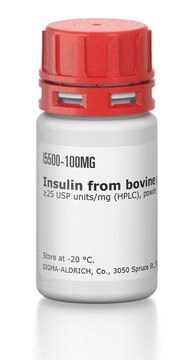U5382
Ubiquitin human
≥95% (SDS-PAGE), recombinant, expressed in E. coli (N-terminal FLAG® tagged), lyophilized powder
About This Item
Productos recomendados
biological source
human
Quality Level
recombinant
expressed in E. coli (N-terminal FLAG® tagged)
assay
≥95% (SDS-PAGE)
form
lyophilized powder
mol wt
10 kDa
technique(s)
mass spectrometry (MS): suitable
solubility
0.05 M Tris pH 7.5: ≥10 mg/mL, clear to slightly hazy, colorless
0.05 M Tris pH 7.5: ≥10 mg/mL
storage temp.
−20°C
¿Está buscando productos similares? Visita Guía de comparación de productos
General description
Ubiquitin is a highly conserved protein composed of 76 amino acids, and it is expressed universally in all eukaryotes, ranging from yeast to humans.
Application
Biochem/physiol Actions
Packaging
Preparation Note
Legal Information
Storage Class
11 - Combustible Solids
wgk_germany
WGK 3
flash_point_f
Not applicable
flash_point_c
Not applicable
ppe
Eyeshields, Gloves, type N95 (US)
Certificados de análisis (COA)
Busque Certificados de análisis (COA) introduciendo el número de lote del producto. Los números de lote se encuentran en la etiqueta del producto después de las palabras «Lot» o «Batch»
¿Ya tiene este producto?
Encuentre la documentación para los productos que ha comprado recientemente en la Biblioteca de documentos.
Los clientes también vieron
Nuestro equipo de científicos tiene experiencia en todas las áreas de investigación: Ciencias de la vida, Ciencia de los materiales, Síntesis química, Cromatografía, Analítica y muchas otras.
Póngase en contacto con el Servicio técnico







